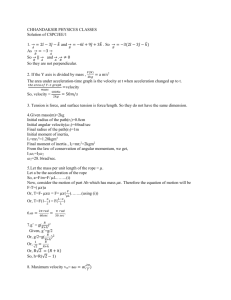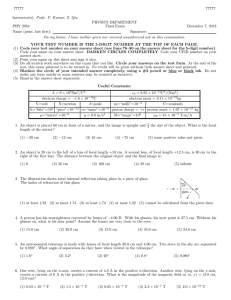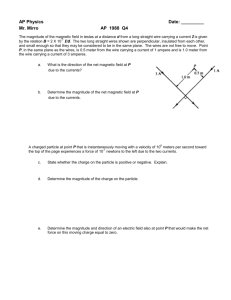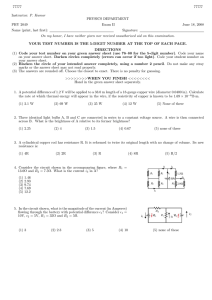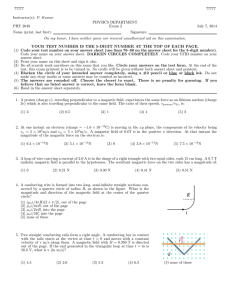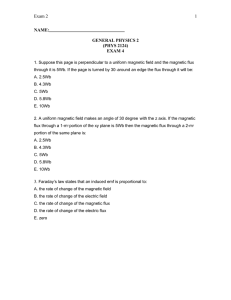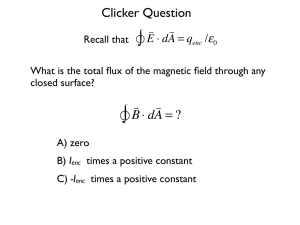77777 F. Rojas PHYSICS DEPARTMENT PHY 2049
advertisement
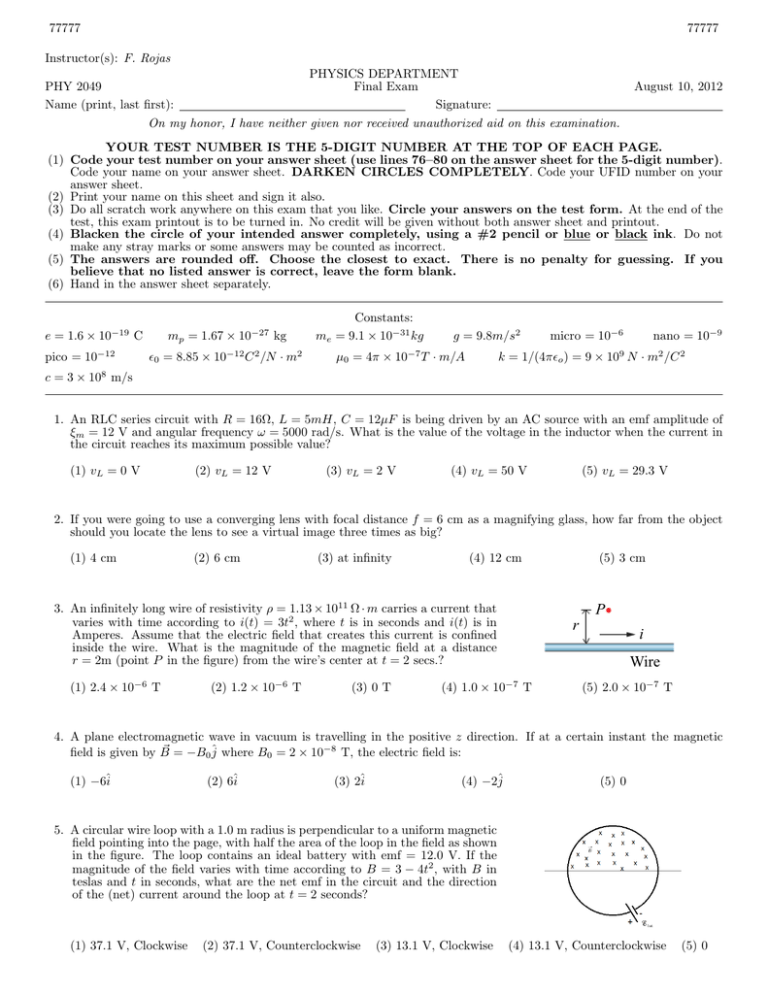
77777 77777 Instructor(s): F. Rojas PHYSICS DEPARTMENT PHY 2049 Final Exam Name (print, last first): Signature: On my honor, I have neither given nor received unauthorized aid on this examination. August 10, 2012 YOUR TEST NUMBER IS THE 5-DIGIT NUMBER AT THE TOP OF EACH PAGE. (1) Code your test number on your answer sheet (use lines 76–80 on the answer sheet for the 5-digit number). Code your name on your answer sheet. DARKEN CIRCLES COMPLETELY. Code your UFID number on your answer sheet. (2) Print your name on this sheet and sign it also. (3) Do all scratch work anywhere on this exam that you like. Circle your answers on the test form. At the end of the test, this exam printout is to be turned in. No credit will be given without both answer sheet and printout. (4) Blacken the circle of your intended answer completely, using a #2 pencil or blue or black ink. Do not make any stray marks or some answers may be counted as incorrect. (5) The answers are rounded off. Choose the closest to exact. There is no penalty for guessing. If you believe that no listed answer is correct, leave the form blank. (6) Hand in the answer sheet separately. e = 1.6 × 10−19 C pico = 10−12 mp = 1.67 × 10−27 kg ²0 = 8.85 × 10−12 C 2 /N · m2 Constants: me = 9.1 × 10−31 kg g = 9.8m/s2 µ0 = 4π × 10−7 T · m/A micro = 10−6 nano = 10−9 k = 1/(4π²o ) = 9 × 109 N · m2 /C 2 c = 3 × 108 m/s 1. An RLC series circuit with R = 16Ω, L = 5mH, C = 12µF is being driven by an AC source with an emf amplitude of ξm = 12 V and angular frequency ω = 5000 rad/s. What is the value of the voltage in the inductor when the current in the circuit reaches its maximum possible value? (1) vL = 0 V (2) vL = 12 V (3) vL = 2 V (4) vL = 50 V (5) vL = 29.3 V 2. If you were going to use a converging lens with focal distance f = 6 cm as a magnifying glass, how far from the object should you locate the lens to see a virtual image three times as big? (1) 4 cm (2) 6 cm (3) at infinity (4) 12 cm 3. An infinitely long wire of resistivity ρ = 1.13 × 1011 Ω · m carries a current that varies with time according to i(t) = 3t2 , where t is in seconds and i(t) is in Amperes. Assume that the electric field that creates this current is confined inside the wire. What is the magnitude of the magnetic field at a distance r = 2m (point P in the figure) from the wire’s center at t = 2 secs.? (1) 2.4 × 10−6 T (2) 1.2 × 10−6 T (3) 0 T (5) 3 cm P r i Wire (4) 1.0 × 10−7 T (5) 2.0 × 10−7 T 4. A plane electromagnetic wave in vacuum is travelling in the positive z direction. If at a certain instant the magnetic ~ = −B0 ĵ where B0 = 2 × 10−8 T, the electric field is: field is given by B (1) −6î (2) 6î (3) 2î (4) −2ĵ (5) 0 5. A circular wire loop with a 1.0 m radius is perpendicular to a uniform magnetic field pointing into the page, with half the area of the loop in the field as shown in the figure. The loop contains an ideal battery with emf = 12.0 V. If the magnitude of the field varies with time according to B = 3 − 4t2 , with B in teslas and t in seconds, what are the net emf in the circuit and the direction of the (net) current around the loop at t = 2 seconds? (1) 37.1 V, Clockwise (2) 37.1 V, Counterclockwise (3) 13.1 V, Clockwise (4) 13.1 V, Counterclockwise (5) 0 77777 77777 6. The figure shows a spherical shell with an unknown uniform volume charge density ρ. Its inner and outer radii are a = 20 cm, and b = 50 cm respectively. What is the charge density ρ if the magnitude of electric field at r = 30cm is E = 12 N/C? (1) (2) (3) (4) (5) 1.5nC/m3 0.19nC/m3 0.57nC/m3 0 8.92nC/m3 7. If you wish to levitate a square black totally absorbing piece of cardboard by shinning light at it, what should the intensity of the light be? The side of the square cardboard is L = 10 cm and its mass is m = 100 grs. (Use g = 9.8m/s2 for the gravitational acceleration) g (1) 2.94 × 1010 W/m2 (2) 5.88 × 1010 W/m2 (3) 2.94 × 1013 W/m2 (4) 5.88 × 1013 W/m2 (5) 1.97 × 1010 W/m2 8. An unpolarized beam of light with intensity 50 W/m2 is incident on a stack of 3 polarizing sheets with each sheet’s polarization axis rotated an angle θ relative to that of the previous sheet. If the beam emerging from the stack has intensity 9 W/m2 , what is its intensity after it has passed through the first 2 sheets? (1) 15 W/m2 (2) 30 W/m2 (3) 25 W/m2 (4) 19.3 W/m2 (5) 7.5 W/m2 9. When an object is placed 20 cm in front of a spherical mirror the magnification is +2.5. What type of mirror this is, and what is its radio of curvature? (1) (2) (3) (4) (5) R = 66.6 cm, Concave R = 133.2 cm, Concave R = 66.6 cm, Convex R = 133.2 cm, Convex R = 28.6 cm, Concave 10. In the figure, the arrow (the object) stands on the common central axis of two thin, symmetric converging lenses. Lens 1 is closer to the object, at an object distance of 15 cm. Lens 2 is located a distance d = 67 cm from Lens 1. Lens 1 has a focal length f1 = 12 cm and Lens 2 has a focal length f2 = 10 cm. What are the absolute value of the magnification and the type of image? (1) 13.3, Virtual (2) 13.3, Real (3) 4, Real (4) 4, Virtual (5) 60, Virtual 11. The figure shows an electric field that is directed into of the page within a circular region of radius R. The magnitude of the electric, as a function of time and the radial distance r with respect to the center, is given by E(r, t) = b t/r (i.e. it increases with time and decreases with r) where b is just a constant number. The magnitude of the magnetic field as a function of r and t is given by (1) B = µ0 ²0 b (2) B = µ0 ²0 b 2πr (3) B = µ0 ²0 b ln r (4) B = µ0 ²0 b t (5) B = µ0 ²0 b t 2πr 77777 77777 12. An electron enters a region where a magnetic field is directed into the page as shown. If me , q, and B represent the mass of the electron, the charge of the electron, and the magnitude of the magnetic field respectively, how much time will the electron take to complete the semi-circular trajectory and in which direction will it rotate? πme (1) t = , Clockwise qB 2πme (2) t = , Clockwise qB πme (3) t = , Counterclockwise qB 2πme (4) t = , Counterclockwise qB (5) It is not possible to determine this with the information provided 13. In the figure R = 20Ω, C = 15 µF , and L = 20 mH, and the ideal battery has emf ξ= 3 V. The switch is kept at position a for a long time and then thrown to position b. What is the amplitude of the charge oscillations in the capacitor? (1) (2) (3) (4) (5) 45 µC 82 mC 13 µC 90 µC None of these 14. In the figure, the ideal batteries have emfs ξ1 = 25 V and ξ2 = 10 V and the resistances are R1 = 2Ω and R2 = 3Ω. If the potential at a is 40 V, what is it at b? (1) (2) (3) (4) (5) 24 V 12 V -16 V 3V 9V 15. In a double-slit experiment, the distance between slits is 5.0 mm and the slits are 2.0 m from the screen. Two interference patterns can be seen on the screen: one due to light of wavelength 510 nm, and the other due to light of wavelength 720 nm. What is the separation on the screen between the second-order (m = 2) bright fringes of the two interference patterns? (1) 0.168 mm (2) 0.840 mm (3) 2.88 mm (4) 2.04 mm 16. In the figure, if the voltage across points P and Q is 14 V, what is the charge on the 4µF capacitor? (1) (2) (3) (4) (5) 24 µC 8.2 µC 12 µC 0C 14 µC (5) 72 µm
